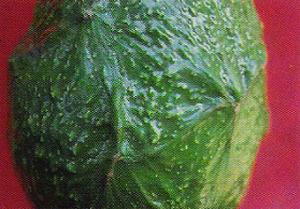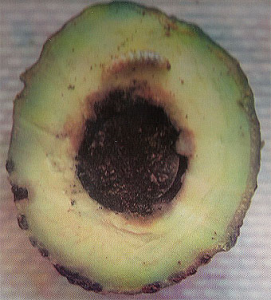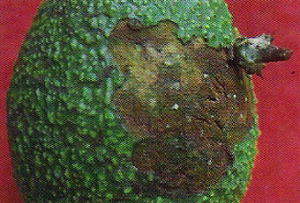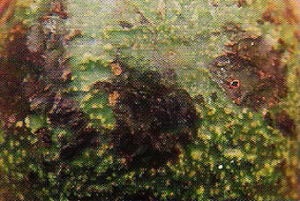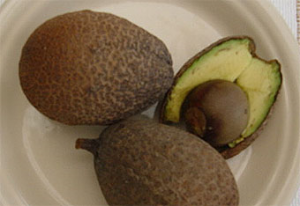Back to > Major Fruits | Minor Fruits | Underutilized Fruits
![]()
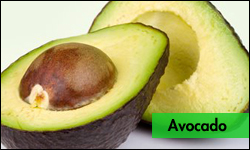 |
||
|
|
||
For more plant health information, including diagnostic resources, best-practice pest management advice and plant clinic data analysis for targeted crop protection, visit CABI’s Plantwise Knowledge Bank.
Pests: Thrips Liothrips persea Watson, Scirtothrips aceri Moulton, Frankiniella cephalica, Heliothrips haemorrhoidalis (Insecta:Thysanoptera: Thriphidae). Similar to the red mite complex, the thrip pests are constituted by several species in every region. They are found inFlorida,California,Mexico, Central andSouth America,Argentina andChile. Thrips have a stronger presence in tropical and subtropical coastal zones, and their damage is reduced in the avocado cultivars located between 1900 and 2400 m of altitude.
Thrips are small insects that survive on foliage, by scraping and sucking the superficial cells, thereby causing the appearance of discolored spots, which are silver-white at firs, and later turn dark. This is observed more often on leaves and fruits, however, they can also be found on tender shoots, buds, and flowers. The damages produced by this pest can make the crop loose up to 50% of its commercial value (Adame, 1994). The major damage is caused when the thrips feed on young fruits, producing crest-shaped malformations of the exocarp.
Small seed weevil, Conotrachelus perseae Barber (Coleoptera: Curculiondae: Cryptorhynchinae). It is found in the eastern central region of Mexico and northern parts of Central America, Guatemala, and Panama. The larvae are of yellowish white color with a dark cephalic capsule, and reach a length of 6 mm. They tunnel, forming a gallery throughout the pulp until they arrive at the seed, which is usually destroyed. Highly infected areas can affect up to 85% of the fruit, destroy the seeds and notably affect the production since this situation induces the falling of the fruit from buds to maturity (Martinez et al. 1987).
Large seed weevil, Heilipus lauri Boheman (Coleptera: Curculionidae: Hylobiinae). The adults are large beaked weevils, 12 to 15 mm in length, of bright reddish-black color with a rough dorsal section, and elytra with 2 yellow stripes. The larvae are curved in shape, legless and of a creamy white color. They tunnel through the flesh of the fruit, forming a gallery that extends to the seed, which is usually destroyed. Furthermore, they produce secondary rotting of the flesh and the seed. This pest affects up to 80% of the production as they destroy the flesh, seeds, and cause a premature falling of the fruits (Bravo et al. 1988).
Seed moth, Stenoma catenifer Walsingham (Lepidoptera: Stenomidae). Seed moths can penetrate fruits of any size and destroy the seed completely. The galleries they form inside the branches cause withering, reduce flowering of the tree and seriously damage up to 90% of the production (Bravo et al. 1988).
Red or brown mites, Oligonychus (Homonychus): Opunicae hirst, O. yothersi Mc. Gregor, O. platani Mc. Gregor, and Eotetranychus sexmaculatus Riley. Acarina: Tetranychidae. The insect complex designed as red or brown mite is present in most of the avocado producing countries, different kinds prevailing in accordance to environmental and climatic conditions. For example, O. punicae is the most widely distributed, being found in California, Florida, Brazil, Argentina, Colombia, Ecuador, Chile and Central America. O. platani is found in the states of California, Arizona, and Texas, as well as in Coahuila (in the north of Mexico). E. sexmaculatus is found inCalifornia,Florida andArizona.
O. punicae attacks the surface of leaves, mainly near the nervation where dusty-like colonies are formed. These mites attack the surface of leaves, produce abundant colonies and hibernate as eggs. The attacks to the trees are more severe during the dry season, with a relative humidity lower than 60%. Rain severely affects these mites, violently decreasing their population at the beginning of the rainy season. When sucking the sap out from the cells, the mites alter the proportions of chlorophyll and photosyntates, which produces the chlorosis symptom: brown coloration of leaves and defoliation. Furthermore, the carbon-nitrogen ratio is altered which reduces the production of growth elements. This results in the reduction of budding, flowering, foliage development, and consequently, the fruit production for the next season (López, 1990).
Leaf roller worm and Amorbia moth (Amorbia emigratella Busck, A. cuneana Walsingham, A. essigana Busck (Lepidoptera:Tortricidae). The various species of Amorbia can be found inCalifornia,Mexico, and Central American countries such asGuatemala,Costa Rica andPanama. It is an endemic pest, present in the summer months. The damage is caused by the larvae, when destroying a large amount of foliage and tender shoots. More important is the damage done to the fruit, since they frequently bind together fruits and/or leaves with their webs, taking shelter and feeding of them, producing injuries that can favor secondary rotting (Bailey and Hoffman, 1980).
Rats and squirrels will strip the fruit. Protect with tin trunk wraps. Leaf-rolling caterpillars (Tortrix and Amorbia) may destroy branch terminals. Avocado Brown Mite can be controlled by powdered sulfur. Six-spotted Mite is very harmful; even a small population can cause massive leaf shedding. A miticide may be required if natural predators are absent. Snails can be a problem in areas.
Avocado affected by thrips
Source: Sanidad Vegetal de Salvador Escalante Michoacán, México
Avocado damaged by small seed weevil
Source: Sanidad vegetal de Ziracuaretiro, Michoacán, México
Leaf roller worms and Amorbia moth affect avocados
Source: Sanidad Vegetal de Salvador Escalante Michoacán, México
Diseases of Avocado (Persea americana Miller):
BACTERIAL DISEASES
Bacterial canker (Pseudomonas syringae) van Hall (S. Africa)
Xanthomonas campestris (Pammel) Dowson (California)
Blast and bacterial fruit spot (Pseudomonas syringae) van Hall
Crown gall (Agrobacterium tumefaciens) (Smith and Townsend)Conn
FUNGAL DISEASES
Anthracnose (Colletotrichum gloeosporioides) (Penz.) Penz. & Sacc. in Penz.
Glomerella cingulata (Stoneman) Spauld. & Schrenk
Armillaria root rot (shoestring root rot) Armillaria mellea (Vahl:Fr.) P. Kumm.
Rhizomorpha subcorticalis Pers. [anamorph]
Avocado affected by anthacnose
Source: Sanidad Vegetal de Salvador Escalante Michoacán, México
Black mildew (Asteridiella perseae ) (F. Stevens) Hansf.
Branch canker
Botryosphaeria disrupta (Berk. & M. A. Curtis) Arx & E. Müller
B. obtusa (Schwein.) Shoemaker = Physalospora obtusa (Schwein.) Cooke
B. quercum (Schwein.) Sacc. = P. glandicola (Schwein.) N. Stevens
B. rhodina (Cooke) Arx = P. rhodina Cooke
P. abdita (Berk. & M. A. Curtis) N. Stevens in Voorhees = P. fusca N. Stevens
Butt rot Ganodermazonatum Murrill = G. sulcatum Murrill
Cercospora spot (blotch) Pseudocercospora purpurea (Cooke) Deighton
Clitocybe root rot (Armillaria tabescens ) (Scop.:Fr.) Dennis et al. = Clitocybe tabescens (Scop.:Fr.) Bres.
Collar rot
Sclerotinia sclerotiorum (Lib.) de Bary
Dematophora root rot (Dematophora necatrix) Hartig (
Rosellina necatrix Prill. [teleomorph]
Dieback (Diplodia cacaoicola Henn)
Phomopsis sp.
Fruit rot (includes stem end rot & fruit spots)
Botryodiplodia sp. Botryosphaeria obtusa (Schwein.) Shoemaker
B. quercuum (Schwein.) Sacc.
B. rhodina (Cooke) Arx
Botrytis cinerea Pers.:Fr. =B. vulgaris Link:Fr.
Botryotinia fuckeliana (de Bary) Whetzel [teleomorph]
Colletotrichum gloeosporioides (Penz.) Penz. & Sacc. in Penz.
Cylindrocladium scoparium Morg.
Calonectria kyotensis Terashita [teleomorph]
Dothiorella aromatica
(Sacc.) Petr. & Syd.
D. gregaria Sacc.
Fusarium decemcellulare C. Brick
Nectria rigidiuscula Berk. & Broome [teleomorph]
Lasiodiplodia theobromae (Pat.) Griffon & Maubl. =Diplodia natalensis Pole-Evans
N. pseudotrichia Berk. & M. A. CurtisTubercularia lateritia (Berk.) Seifert [anamorph]
Pestalotia sp.
P. versicolor Speg.
Phomopsis perseae Zerova
Rhizopus stolonifer (Ehrenb.:Fr) Vuill.
Sclerotinia sclerotiorum (Lib.) de Bary =S. libertiana Fuckel
Heart rot
Oxyporus latemarginatus (Durieu & Mont.) Donk = Porialatemarginata (Durieu & Mont.) Cooke
Leaf spots
Bipolaris sorokiniana (Sacc.) Shoemaker
Cochliobolus sativa (Ito & Kuribayashi) Drechs. ex Dastur [teleomorph]
Pestalotia sp.
P. adusta Ellis & Everh.
Phyllachora gratissima Rehm
Phyllosticta micropuncta Cooke =P. perseae Ellis & G. Martin
Phomopsis spot (Phomopsis sp.)
Physalospora canker (Physalospora perseae) Doidge
Phytophthora crown rot (Phytophthora cinnamomi) Rand P. citricola Sawada
Phytophthora trunk canker (Phytophthora cinnamomi) Rands P. citricola Sawada P. heveae Thompson
Phytophthora root rot (Phyophthora cinnamomi)Rands
Pink rot (Trichothecium roseum) Lk.:Fr. = Cephalothecium roseum Corda
Powdery mildew (Oidium sp.)
Rhizoctonia seed and root rot (Rhizoctonia solani) Kühn Thanatephorus cucumeris (A. B. Frank) Donk [teleomorph]
Root and bark rot (Fusarium sp.)
Root rot (Pythium sp.)
Rosellinia root rot (Rosellinia bunodes )(Berk. & Broome) Sacc.
Rusty blight (Colletotrichum gloeosporioides) (Penz.) Penz. & Sacc. in Penz. = C. nigrum Ellis & Halst.
Avocado blight caused by Sphaceloma perseae
Scab (fruit & leaf) (Sphaceloma perseae) Jenk.
Seedling blight (Phytophthora palmivora) (E. J. Butler) E. J. Butler Sclerotium rolfsii Sacc. Athelia rolfsii (Curzi) Tu & Kimbrough [teleomorph]
Smudgy spot (Helminthosporium sp.)
Sooty blotch (Akaropeltopsis sp.)
Tar spot (Phyllachora gratissima) Rehm
Verticillium wilt (Verticillium dahliae) Kleb.Wood rots (Fomitella supina (Sw.:Fr.) Murrill = Polyporus supinus (Sw.:Fr.) Fr.
Laetiporus sulphureus (Bull.:Fr.) Murrill =Polyporus sulphureus (Bull.:Fr.) Fr. Sporotrichum versisporum (C. G. Lloyd) Stalpers [anamorph] Rigidoporus ulmarius
(Sowerby:Fr.) Imazeki in Ito = Fomes geotropus (Cooke) Cooke Trames hirsuta (Wulfen:Fr.) Quel. = Polyporus hirsutus (Wulfen:Fr.) Fr.
VIRUSLIKE DISEASES
Sunblotch
Avocado sun-blotch viroid
Trunk pitting
Graft transmissible agent
MISCELLANEOUS DISEASES OR DISORDERS
Algal spot
Cephaleuros virescens Kunze
Black-streak
Unknown cause
Dieback
Copper deficiency
Edema
Physiological
Little leaf rosette
Zinc deficiency
Tip burn
Excess mineral salts
Reference:
- Adame, E.L. 1994. Plagas del aguacate y su control. IV Curso de Aprobación Fitosanitaria en Aguacate. Facultad de Agrobiología. U. M. S. N. H. Uruapan, Michoacán, México.
- Armstrong, WP (2000). “Fruits Of The Rose, Olive, Avocado & Mahagany Families – Laurel Family: Lauraceae Extract from: http://waynesword.palomar.edu/ecoph17.htm#avocado
- “Avocados, raw, California”. NutritionData.com (2007). Retrieved on 2007-12-29
- Bailey, B.J., and P.M. Hoffman. 1980. Amorbia: ACalifornia avocado insect pest. Department of Entomology,University ofCalifornia, División of Agricultural Sciences. Leaflet 21256Riverside, Ca.U.S.A.
- Boyle, E.M. (1980). Vascular anatomy of the flower, seed, and fruit of Lindera benzoin. Bull. Torreya Bot. Club. 107:409-417.
- Bravo, M.H., et al., 1988. Plagas de frutas. Centro de Entomología y Acaralogía , Colegio de Posgraduados. Montecillo, México pp 49-236
- Bruno Razeto, Jose Longueira, and Thomas Fichet. (1992). Proc. ofSecond World Avocado Congress 1992 pp. 273-279
- California Avocado Comission (2007). Avocado.org. Retrieved March 1, 2007, Web site: http://www.avocado.org/
- Davenport, T.L. Avocado Flowering, Hort. Reviews 8: 257-289.
- Dowling, Curtis F.; Morton, Julia Frances (1987). Fruits of warm climates. Miami, Fla: J.F. Morton.
- “FATTY ALCOHOLS: Unsaturated alcohols”. CyberlipidCenter. Retrieved on 2007-12-29.
- Hirokazu Kawagishi, Yuko Fukumoto, Mina Hatakeyama, Puming He, Hirokazu Arimoto, Takaho Matsuzawa, Yasushi Arimoto, Hiroyuki Suganuma, Takahiro Inakuma, and Kimio Sugiyama. (2001). Liver Injury Suppressing Compounds from Avocado (Persea americana). J. Agric. Food Chem., 49 (5), 2215 -2221, 2001. 10.1021/jf0015120 S0021-8561(00)01512-0
- Koch, F.D. (1983). Avocado Grower’s Handbook, Bonsall Publications,
- López, E. 1990. Manejo de plagas de palta. In the international course: “Producción, Postcosecha y Comercialización de Paltas”. Facultad de Agronomía. Universidad Católica de Valparaíso. Viña del Mar, Chile.
- López-López, L., and Cajuste-Bontemps, J.F. 1999. Efecto del envase de carton corrugado y embalaje en la conservación de la calidad de fruta de aguacate CV. Hass. Revista Chapingo Serie Horticultura 5 Núm. Especial: 359-364.
- Martínez, B.R., and Adame, E.L. 1987. El minador de la hojadel aguacatero, dinámica de población, biología y control. Revista: Fruticultura de Michoacán. Año II, (I), 11pp. 5-26.Uruapan Michoacán.
- Minas K. Papademetriou (2000). Avocado Production in Asia and the Pacific. FOOD AND AGRICULTURE ORGANIZATION OF THE UNITED NATIONS
- REGIONAL OFFICE FOR ASIA AND THE PACIFIC
- BANGKOK,THAILAND, JULY 2000
- Naveh E, Werman MJ, Sabo E, Neeman I (2002). “Defatted avocado pulp reduces body weight and total hepatic fat but increases plasma cholesterol in male rats fed diets with cholesterol”. J. Nutr. 132 (7): 2015–8.
- Ohr, H. D. , M. D. Coffer, and R. T. McMillan, Jr. (2003) Diseases of Avocado (Persea americana Miller). http://www.apsnet.org/online/common/names/avocado.asp
- Ojewole JA, Amabeoku GJ. (2006). Anticonvulsant effect of Persea americana Mill (Lauraceae) (Avocado) leaf aqueous extract in mice. Phytother Res, 20(8): 696-700.
- SAGAR Secretaría de Agricultura, Ganadería y Desarrollo Rural. 1999. Revista “Claridades Agropecuarias”, No. 65 “El Aguacate”. Enero de 1999.
- Sánchez-Pérez, J. 2001. Aguacate en postcosecha. Boletín informativo de la APROAM El Aguacatero No. 5, http://www.aproam.com/aguacater5.htm SARH-DGSV. 1981. Lista de insectos y ácaros perjudiciales a los cultivos de México. 2a. Ed. Secretaría de Agricultura y Recursos Hidráulicos – Dirección General de Sanidad Vegetal. Fitófilo, No. 86: 1-196.
- Scora, Rainer. W. and Bergh, B. (1990). THE ORIGINS AND TAXONOMY OF AVOCADO (PERSEA AMERICANA) MILL. LAURACEAE. Acta Hort. (ISHS) 275:387-394
- Thorp, T.G. (1992). A study of modular growth in avocado (Persea americana Mill.) PhD.Dissertation. The University ofAdelaide,South Australia.
- Whiley, A.W. and B. Schaffer. (1994). Avocado, p. 3–35. In: B. Schaffer and P.C. Andersen (eds.). Environmental physiology of fruit crops. vol. 2. Sub-tropical and tropical crops. CRC Press Inc.,Boca Raton,Fla.
- Wikipedia, (2007). Avocado. Retrieved March 5, 2007, from Wikipedia Web site: http://en.wikipedia.org/wiki/Avocado
- Yahia, E.M. 2001. Manejo postcosechadel aguacate, In: Memoria del 1er. Congreso Mexicano y Latinoamericanodel Aguacate.Uruapan, Michoacán, México. Octubre 2001.
- Yahia, E. 2003. Manejo postcosechadel aguacate, 2ª. Parte. Boletín informativo de APROAM El Aguacatero, Año 6, Número 32, Mayo de 2003.

